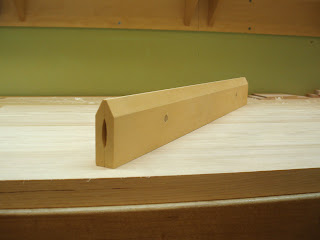Wow Hickory is hard. I knew it was hard but I didn't know it was this hard.
Also it tears. As soon as there is a dive to the grain "shhhh-crugh!" (is that was a tear sounds like?).
Looks like I'm going to reacquaint myself with the cabinet scraper on this one.
Since last time, I have been breaking down the rough lumber, picking what pieces go where, and bringing those close to dimension.
Using the planer was a painfully slow and loud process on a count of the Hickory's hardness.
While I was edge gluing bits to make up the carcass components I worked on the door bending form pictured above. I got a little carried away with the thickness of it, but I'm sure it wont deform under clamping pressure. One could get away with a much thinner form when using a vac press but I'm just going the mechanical route.
I got some sheets of 1/8" Baltic Birch clamped on the form to make the door substrates and moved on to working the main carcass pieces.
Here I'm checking and adjusting the inside of the top, bottom, sides for flatness to make solid tight joints. What I have in my hand is a wooden straight-edge.
Provided that you have stable wood, these are great tools! This kind of straight-edge is of a Japanese tradition, this particular tool was made by my bench-mate at IP, Daisuke Tanaka.
This one is made from amazingly tight grained Yellow Cedar, very stable. You can make them any size you want, and the wood edge wont mar your project. You just use one side as a straight edge, you check that against the other half for trueness, and use a hand plane to adjust. Might sound unfamiliar but they are very accurate.
finally for this installment I got to shaping the outsides of the sides. Being that this Hickory is a bit of a pain to work I tried to rough out the profile closely with a dado set on the table saw. Worked alright but my arms still got tired mighty tired from scraping, sharpening, scraping, sharpening, and scraping. In the end, it looks good.
Sunday, November 24, 2013
Subscribe to:
Post Comments (Atom)








No comments:
Post a Comment